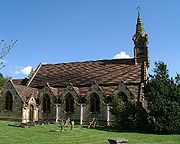
Combrook
Encyclopedia

Warwickshire
Warwickshire is a landlocked non-metropolitan county in the West Midlands region of England. The county town is Warwick, although the largest town is Nuneaton. The county is famous for being the birthplace of William Shakespeare...
, located near the junction of the Fosse Way
Fosse Way
The Fosse Way was a Roman road in England that linked Exeter in South West England to Lincoln in Lincolnshire, via Ilchester , Bath , Cirencester and Leicester .It joined Akeman Street and Ermin Way at Cirencester, crossed Watling Street at Venonis south...
(B4455 road), and the B4086 road between the villages of Wellesbourne
Wellesbourne
Wellesbourne is a large village and civil parish in the county of Warwickshire, in the West Midlands region of the UK. In the 2001 census the parish, which also includes the village of Walton, had a population of 5,691 Wellesbourne is a large village and civil parish in the county of Warwickshire,...
and Kineton
Kineton
Kineton is a village and civil parish on the River Dene in south-eastern Warwickshire, England. The village is part of Stratford-on-Avon district, and in the 2001 census it had a population of 2,278....
.
History
Its history is closely linked with that of the nearby Compton VerneyCompton Verney
Compton Verney is a manor and parish in the county of Warwickshire, England.Compton Verney House is an 18th century country mansion which has been converted into an art gallery....
estate, for which it once served as the estate village, providing living accommodation for a number of the servants.
The village dates from at least the time of Henry I
Henry I of England
Henry I was the fourth son of William I of England. He succeeded his elder brother William II as King of England in 1100 and defeated his eldest brother, Robert Curthose, to become Duke of Normandy in 1106...
, circa 1086, when a small medieval church was built in the village. There is, however, no separate reference to it in the Domesday book
Domesday Book
Domesday Book , now held at The National Archives, Kew, Richmond upon Thames in South West London, is the record of the great survey of much of England and parts of Wales completed in 1086...
. By 1279, following a stocktaking by Edward I
Edward I of England
Edward I , also known as Edward Longshanks and the Hammer of the Scots, was King of England from 1272 to 1307. The first son of Henry III, Edward was involved early in the political intrigues of his father's reign, which included an outright rebellion by the English barons...
known as the Hundred Rolls
Hundred Rolls
The Hundred Rolls are a census of England and parts of what is now Wales taken in the late thirteenth century. Often considered an attempt to produce a second Domesday Book, they are named for the hundreds by which most returns were recorded....
, Combrook was identified as located in the Kineton hundred. It remained part of the Kineton parish until 1858, when it was separated from Kineton and united with the ecclesiastical parish of Compton Verney
Compton Verney
Compton Verney is a manor and parish in the county of Warwickshire, England.Compton Verney House is an 18th century country mansion which has been converted into an art gallery....
.
A number of the buildings in the village have a similar style, most easily seen in the church. The original church was modified in Tudor
Tudor
- Architecture :*Tudor architecture, the final development of medieval architecture during the Tudor period *Tudor Revival architecture, also called Mock Tudor, refers to the 20th century emulation of Tudor architecture-Entertainment:...
times, with the chancel being rebuilt again in 1831. The present building was erected in 1866, to a design by John Gibson, paid for by the Dowager Lady Margaret Willoughby de Brook of Compton Verney
Compton Verney
Compton Verney is a manor and parish in the county of Warwickshire, England.Compton Verney House is an 18th century country mansion which has been converted into an art gallery....
, keeping the existing chancel. John Gibson went on to design the Victorian neo-Elizabethan estate houses and the horse drinking troughs in the village in the same style as that of the church. A number of the other houses in the village are thatched, with clear signs of original thatched roofs visible on several other dwellings. Until the sale of the Compton Verney estate in 1929, Combrook was a "closed" village, entirely owned by the Lord of the Manor
Lord of the Manor
The Lordship of a Manor is recognised today in England and Wales as a form of property and one of three elements of a manor that may exist separately or be combined and may be held in moieties...
, who could determine who lived there, and Combrook today is still considered to be one of the best-preserved estate villages in the country.
The largest house in Combrook once served as the school, and there has been a school on the site since at least 1641. The building which now serves as the village hall was built as the village school in 1855, and seems to have served as a design template for John Gibson's style for the church and estate houses. The village school was closed in 1966.

